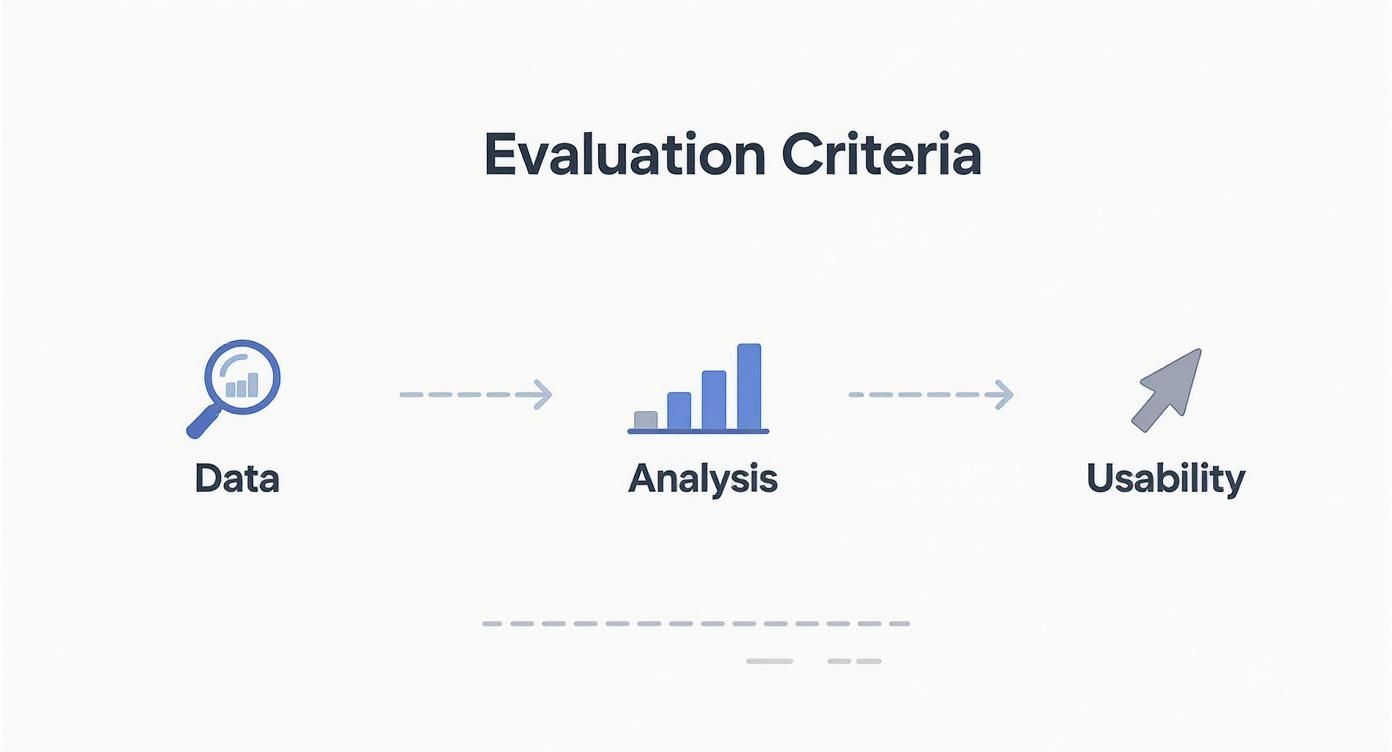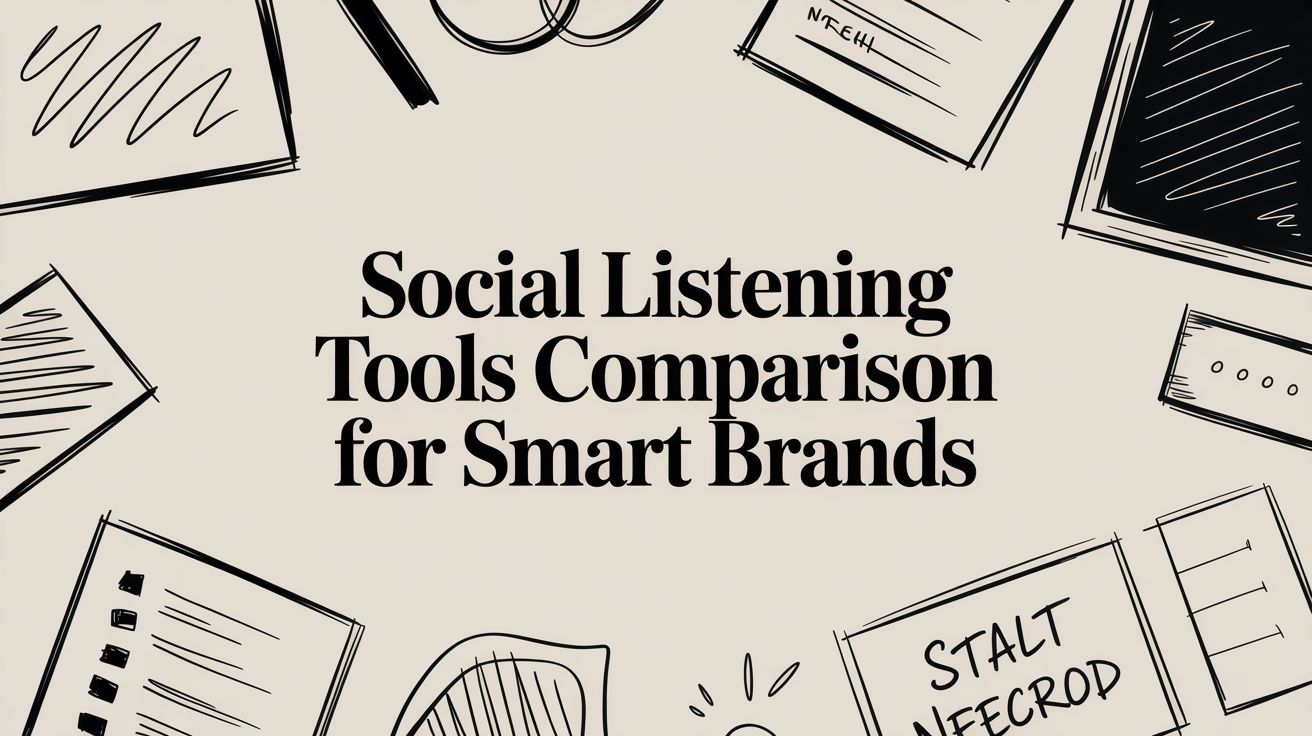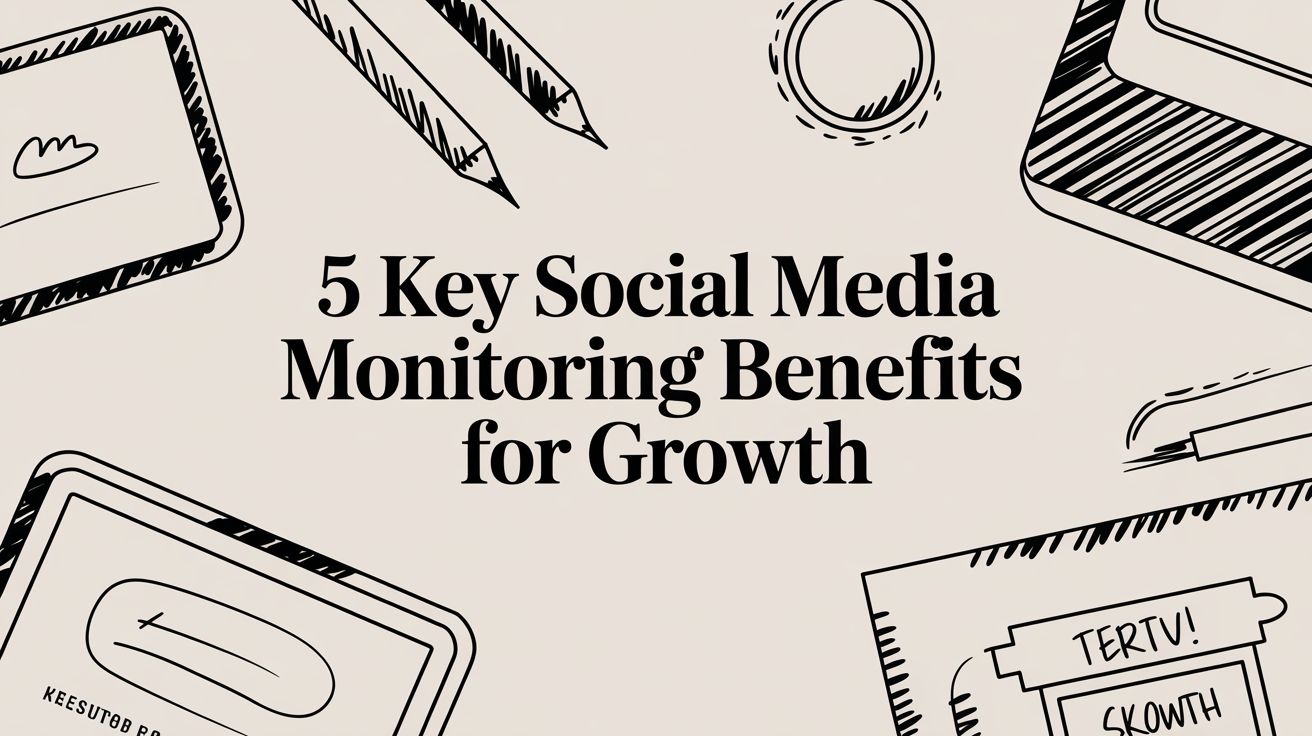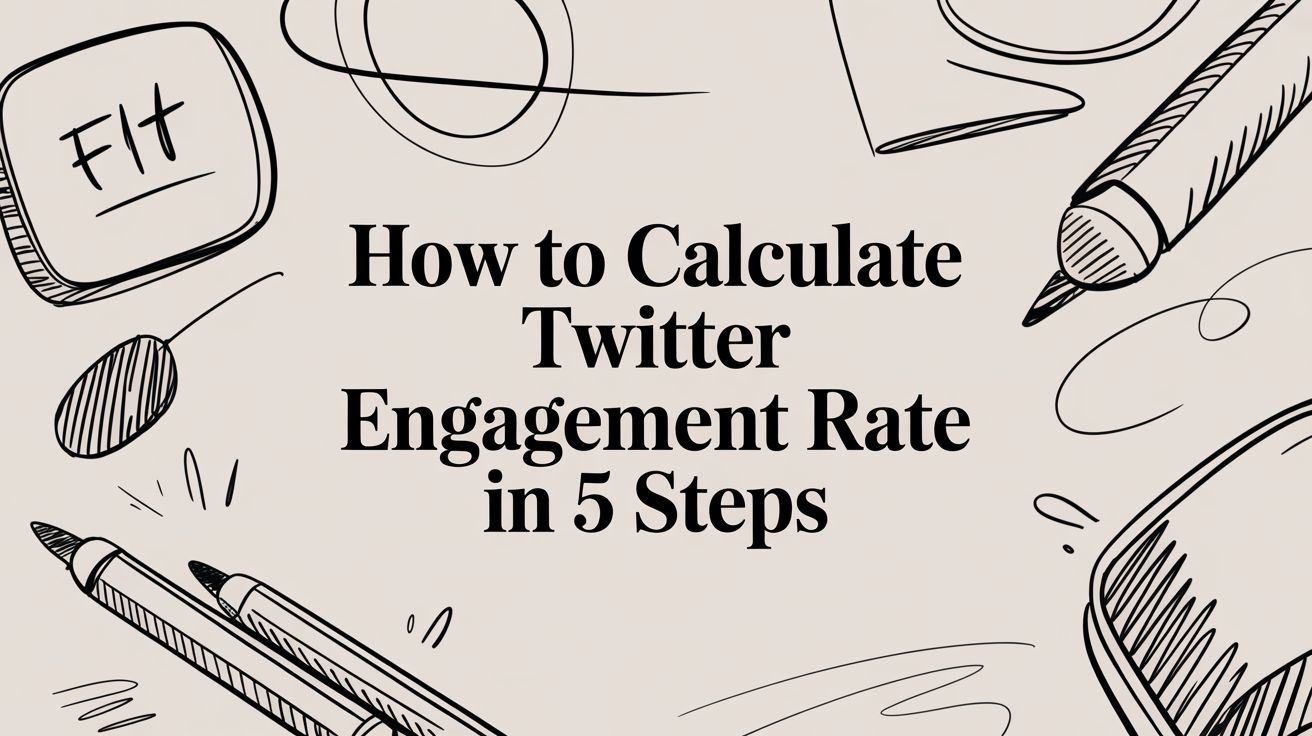If you think social listening is just a background task for the marketing team, it's time to think again. It's no longer an optional add-on; it's a core part of how smart businesses operate. Getting this right means you understand what customers actually think and want, giving you a serious leg up on competitors who are still just guessing.
Why Social Listening Is No Longer Optional

Social listening has made the leap from a "nice-to-have" marketing chore to a must-have for the whole organization. It’s all about systematically tracking mentions of your brand, your competitors, and the conversations happening across your industry to gather real intelligence. Think of it as your company's radar—it doesn't just catch what's said to you, but everything being said about you.
This constant stream of feedback is a massive competitive advantage. When you grasp the "why" behind the online chatter, you can make sharper decisions everywhere, from product development to customer support. Our upcoming social listening tools comparison will dig into the "how," but let’s first lock down why it’s so important.
The Real-World Business Wins from Listening
This isn't just about vanity metrics. Active listening turns raw, unstructured conversations into fuel for real growth.
- Get Ahead of a Crisis: When you spot a wave of negative sentiment or a piece of misinformation early on, you can jump in and manage it before it snowballs into a full-blown reputation disaster.
- Build Better Products: Your customers are talking, and their conversations are a goldmine. You can uncover common pain points, brilliant feature ideas, and gaps in the market your competitors have completely missed.
- Elevate Your Customer Service: Listening helps you find customers who are frustrated but aren't talking to your official support channels. Solving their problems proactively can turn a detractor into a loyal fan.
- Outsmart the Competition: By keeping tabs on your competitors' mentions, you can see what they're doing right, where they're falling short, and what their customers are complaining about. It's the perfect way to find an opening and set your brand apart.
Knowing the 'why' is the first step toward building truly effective social media strategies. It's a proactive mindset that helps you shape your market position instead of just reacting to it.
"Listening to your audience is everything. It’s at the heart of it all. Brands can’t afford to ignore their customers anymore. Now? Social listening is no longer an option—it’s a must!” - Abeer Alessa, CEO of The Bold Group
This isn't just a trend; the money proves it. The global market for social listening tools is projected to reach about $9.61 billion by 2025, a clear sign that businesses are doubling down on reputation management and customer intelligence. If you want to dive deeper into the market data, check out the analysis from WK Information. Understanding the full scope of social media monitoring benefits will put you in a much better position to choose the right tool for the job.
How We Judged the Social Listening Tools
To give you a genuinely useful comparison, we went way beyond just looking at feature lists. We developed a straightforward evaluation process based on what actually matters when you're using these tools day-to-day. This wasn't about a simple checklist; it was about judging each platform on how it would actually help (or hinder) a real business.
We put ourselves in the shoes of marketing, PR, and product teams to see how each tool holds up under pressure. Think of this as our scoring rubric—the foundation for everything you'll read in this guide.
Data Coverage: Are They Listening Everywhere?
A social listening tool is only as good as its ears. The first thing we dug into was the breadth and depth of what each platform monitors. It’s not enough to just cover the big names like X (formerly Twitter) and Instagram anymore.
We looked for tools that pull in conversations from a wide range of places:
- Social Platforms: This includes the usual suspects, but also emerging networks and niche forums where your real customers are talking.
- News and Media: We checked for access to both global and local news, press releases, and even broadcast mentions.
- Blogs and Forums: Monitoring key industry blogs, review sites, and communities like Reddit is non-negotiable.
- Historical Data: Can you look back in time to spot long-term trends, or are you stuck only seeing what’s happening right now?
If a tool misses a critical conversation happening on a forum or a news site, its value plummets. We gave higher marks to platforms that cast the widest, most relevant net, so you can be confident you're getting the full picture.
Analysis and Accuracy: Turning Noise into Insight
Collecting mentions is the easy part. The real magic is in making sense of it all. We spent a lot of time testing each tool's ability to analyze raw data and pull out insights you can actually use. A major focus here was sentiment analysis—we threw sarcasm and tricky industry jargon at it to see how well it kept up.
A tool that misinterprets a sarcastic tweet as a glowing review can send your entire strategy off a cliff. We favored platforms with smarter AI that not only understands nuance but also lets you manually correct mistakes, so it gets better over time.
We also looked at how well the tools identify trends. The best ones don't just show you a chart with a spike in mentions; they help you understand why it happened. This means spotting key themes, measuring your share of voice against competitors, and identifying the influential people driving the conversation. To get the most out of these features, you first need to know how to measure social media engagement correctly.
Usability: Can Your Team Actually Use It?
The most powerful tool in the world is completely useless if it’s a pain to use. We put a heavy emphasis on the overall user experience (UX). We were looking for clean dashboards, intuitive navigation, and a workflow that doesn’t require a PhD to figure out.
We specifically looked at a few key things:
- Getting Started: How fast can a new team member jump in and set up their first search query without needing a week of training?
- Reports and Dashboards: Is it easy to build custom reports that you can share with your boss or clients without having to spend hours exporting and formatting data?
- Team Collaboration: Can your team work together inside the tool to assign tasks, flag important mentions, and coordinate responses?
- Integrations: Does it play nice with the other tools you already use, like your CRM, analytics platform, or helpdesk software?
Our goal was to find tools that feel like a natural part of your team's workflow, not just another piece of complicated software you have to manage.
A Detailed Social Listening Tools Comparison
Trying to pick the right social listening platform can feel like a fool's errand. Every tool on the market claims to give you the ultimate view of your brand online, but the truth is, they all have different strengths, blind spots, and are built for very different kinds of teams. This comparison cuts through the marketing fluff to give you a real, head-to-head look at the heavyweights: Brandwatch, Sprinklr, Talkwalker, and Sprout Social.
My goal here is to get into the nitty-gritty differences that actually affect your day-to-day work and strategic planning. We'll look at how each one handles the basics—like pulling data, figuring out sentiment, and building reports—so you can find the tool that truly matches what you need to get done.
This infographic lays out the three pillars we're using for this evaluation. It’s all about the right mix of data, analysis, and simple usability.

As you can see, a great tool isn't just about hoarding data. It has to give you smart, easy-to-use ways to make sense of it all.
Brandwatch: The Data Science Powerhouse
Brandwatch has built its reputation as a beast in the listening world, and for good reason. It boasts one of the most massive data libraries you can get your hands on, monitoring over 100 million sources and holding a historical archive of more than 1.7 trillion conversations going all the way back to 2010. If you need to do serious historical research or track trends over the long haul, this is your platform.
Its real magic, though, is in its AI-driven analytics. Brandwatch uses some seriously sophisticated natural language processing (NLP) to deliver sentiment analysis that actually gets the nuance right. It goes beyond just "positive" or "negative," often picking up on complex emotions, intent, and even sarcasm where other tools fall flat.
Key Differentiator: The Iris AI feature is a game-changer. It’s a predictive analytics tool that automatically flags weird trends and conversation shifts before they hit the mainstream. For an enterprise PR team, that kind of early warning system is gold for getting ahead of a crisis or jumping on an opportunity.
But all that power doesn't come easy—or cheap. The learning curve is steep, and you practically need to be a wizard with Boolean logic to build complex queries. Its interface can feel like a cockpit to a first-time user, making it a better fit for dedicated analysts and big enterprise teams who have the time and budget to really dig in. When you're making a detailed comparison of social listening tools, it's always wise to look at the market leaders, but also check out some Brandwatch alternatives to get a feel for different features and pricing.
Sprinklr: The Unified Enterprise Platform
Sprinklr doesn’t even call itself just a listening tool. It’s a "Customer Experience Management" (CXM) platform, and that tells you everything you need to know. Its entire selling point is that it pulls social listening into a massive suite that also handles marketing, advertising, research, and customer service. For huge, often siloed, organizations, this creates one central hub for everything customer-facing.
The platform keeps an eye on over 30 social channels and more than a billion other online sources, giving it the kind of global reach few others can claim. Sprinklr's AI is built to understand customer intent on a massive scale, helping support teams find urgent problems and marketers spot buying signals in the noise.
Where it really shines is in its workflow automation. A single mention picked up by the listening module can be turned into a support ticket, shot over to an agent, and tracked until it’s resolved, all without ever leaving the Sprinklr ecosystem.
Of course, this all-in-one machine is a bear to implement and comes with a hefty price tag. It’s a true enterprise solution for global brands coordinating across dozens of departments. Smaller teams will likely find it’s way more than they need.
Talkwalker: The Global Intelligence Engine
Talkwalker's sweet spot is its incredible global coverage and slick visual analytics. It monitors over 30 social networks and 150 million websites, but its secret weapon is its image and video recognition tech. Talkwalker can spot logos, objects, and even specific scenes in visual content, even if your brand name is never mentioned in the text.
This is huge for brands that live and die on visual platforms like Instagram and TikTok, or for anyone trying to track the ROI of a sponsorship. Think about it: you can track every single time your logo appeared in the background of a fan's video at an event. That's the level of detail we're talking about.
Its AI-powered sentiment analysis also works across dozens of languages, making it a go-to for international brands managing their reputation worldwide. On top of that, the platform is known for its clean dashboards and user-friendly design, which makes all that advanced data feel much more approachable.
Talkwalker really hits that middle ground between the raw data muscle of Brandwatch and the all-encompassing approach of Sprinklr. It gives you advanced features without the overwhelming complexity.
Sprout Social: The All-in-One SMB Champion
At its core, Sprout Social is a social media management platform that has layered in some seriously solid listening features. Its biggest advantage is how it seamlessly blends listening with publishing, engagement, and analytics in one clean, intuitive package. For small to mid-sized businesses (SMBs) and agencies, this unified workflow is a massive time-saver.
You don't need one tool to schedule your posts and another to see what people are saying. With Sprout, you can spot a relevant conversation, jump in to respond, assign it to a teammate, or schedule a follow-up post—all from the same screen.
Sprout’s listening is more than capable for most everyday needs. It tracks conversations across the big social platforms plus blogs, forums, and news sites, and its sentiment and trend reports are easy to understand. It just doesn't have the colossal historical archive of Brandwatch or the deep visual analytics of Talkwalker.
Its true strength is how easy it is to pick up and use.
- Ease of Use: Sprout is famous for its clean interface that you can learn in an afternoon.
- Integrated Workflow: Being able to go from listening to action in a single click is its main draw.
- Transparent Pricing: Unlike the enterprise giants, Sprout has clear pricing tiers that are much easier for smaller businesses to plan for.
This makes Sprout the obvious choice for teams who need a great all-around social media management tool with listening built-in, rather than a specialized platform just for data analysts.
Feature Showdown: Key Social Listening Tools
To really boil it down, let’s look at these tools side-by-side. This table gets right to the point, highlighting what makes each platform unique, from their data sources to the kind of user they’re built for.
| Feature | Brandwatch | Sprinklr | Talkwalker | Sprout Social |
|---|---|---|---|---|
| Primary Strength | Deep Data & AI Analytics | Unified CXM Platform | Global & Visual Intelligence | Integrated SMM Workflow |
| Data Coverage | 1.7T+ historical posts | 30+ social channels, 1B+ sites | 150M+ sites, extensive global | Major platforms, news, blogs |
| Key Differentiator | Predictive AI (Iris) | End-to-end workflow automation | Advanced image/video recognition | Seamless listen-to-publish UX |
| Best For | Enterprise Analysts & Researchers | Large, Global Corporations | International Brands & PR Teams | SMBs & Marketing Agencies |
| Learning Curve | High | High | Medium | Low |
In the end, the "best" tool really just depends on your team's size, goals, and budget. An enterprise research team is going to need the depth of Brandwatch, while a fast-moving marketing team will get more done with the all-in-one efficiency of Sprout Social. Use this comparison as your guide to match a platform’s strengths to what you actually need to accomplish.
Choosing the Right Tool for Your Business Goals
I've seen it a hundred times: a team gets excited about a long list of features on a pricing page, only to realize the tool doesn't actually fit their day-to-day needs. The "best" social listening platform is always the one that aligns with your team's size, budget, and what you’re truly trying to accomplish. It’s about moving past a checklist and mapping a tool's strengths to your reality.
Let's break down which platforms make the most sense for common business scenarios. This isn't just about features; it's about connecting capabilities to a strategic advantage, so you can see why one tool might be a game-changer while another is just an expensive distraction.
For Enterprise-Scale Crisis Monitoring
When you're a large enterprise, especially in a sensitive industry, you simply can't afford to miss a single conversation. The main goal here isn't marketing—it's comprehensive risk mitigation and real-time crisis management. You need a massive data library, sophisticated alerts, and serious analytical power.
Top Recommendation: Brandwatch
Brandwatch was practically built for this. With access to over 100 million sources and a deep historical database, it ensures nothing slips through the cracks. Its predictive AI, Iris, is designed to spot unusual spikes in negative sentiment or conversation volume, giving PR teams a crucial head start before a story explodes.
The real power of Brandwatch is its ability to filter signal from noise at an immense scale. For a global brand, identifying a localized issue in one region and containing it before it goes international is an invaluable capability that easily justifies the investment.
Yes, it has a steep learning curve, but for an organization where brand reputation is a top-tier business metric, that’s a trade-off worth making for the level of intelligence it provides.
For Agencies Juggling Multiple Client Brands
Agencies have a unique challenge. They need powerful listening capabilities, but they also need to be incredibly efficient. They're managing multiple clients, each with different goals, keywords, and reporting demands. The perfect tool for an agency blends robust monitoring with an interface that doesn't make client management a chore.
Top Recommendation: Talkwalker
Talkwalker hits that sweet spot perfectly. It offers powerful global and visual intelligence—like logo recognition—which is a huge plus for clients with event sponsorships or a strong visual presence. More importantly, its dashboards are intuitive and can be duplicated for new clients in minutes, slashing setup time.
This means an account manager can quickly build and share insightful reports without needing a data science degree. Its ability to measure your brand’s prominence against competitors is also critical for showing value. After all, understanding how to calculate share of voice is a fundamental part of proving ROI to clients.
For Startups Tracking Product-Market Fit
Startups and smaller businesses are playing a different game. They're often strapped for resources and need a tool that delivers immediate, actionable insights without a huge budget or a dedicated analyst. The focus is on understanding customer pain points, keeping an eye on competitors, and finding those crucial early adopters.
Top Recommendation: Sprout Social
For this use case, Sprout Social is the clear winner. Its biggest strength is how it integrates solid listening features directly into an all-in-one social media management platform. A founder or a small marketing team can monitor keywords, find relevant conversations, and engage directly—all from one clean inbox.
That seamless workflow is everything when every minute counts. You don't have to switch between tools to go from insight to action. While it lacks the deep historical data of a tool like Brandwatch, it provides more than enough power to track product feedback, spot feature requests, and understand customer sentiment as it happens.
The market definitely favors cloud-based tools, especially for SMBs who need to scale without massive upfront costs. This is part of a larger trend where big enterprises go for comprehensive solutions, while smaller firms want agile, integrated platforms. In fact, North America currently holds nearly 40% of the market, with software-as-a-service making up over 64% of revenues in 2024. You can dig into this more through market research from Archive Market Research. Picking the right tool really comes down to knowing which of these segments you fall into.
The Human Element in Social Listening

While the social listening tools we've compared are incredibly powerful, the data they spit out is only half the battle. Real influence and connection are built by people, not algorithms. Technology is fantastic at finding mentions and spotting trends across the web, but it often fumbles the subtle art of human conversation.
This is where the human element isn't just a nice-to-have—it's essential. An automated tool can flag a keyword, but it can’t always pick up on the sarcasm, cultural context, or inside jokes that a sharp community manager gets in a heartbeat. That distinction is everything. Mistaking a sarcastic jab for genuine praise can send your entire strategy down the wrong path.
Bridging Data with Authentic Engagement
Think of social listening platforms as a targeting system, not a replacement for real interaction. Their job is to make your human touch more efficient and impactful. The real value is in how they pinpoint high-value opportunities where a thoughtful, personalized response will make all the difference.
Your tool is the radar, scanning millions of conversations to find the few that truly matter. It’s then up to a person to step in and craft a response that feels genuine.
- Resolving Complex Issues: A tool can find an angry customer tweet, but only a human can empathize, troubleshoot a tricky problem, and rebuild that fragile trust.
- Forging Strategic Partnerships: Automation might spot an influencer talking about your niche, but it takes a personalized email from a real person to start a meaningful partnership.
- Uncovering Deeper Insights: A human analyst can read between the lines, picking up on unspoken needs or frustrations that AI-driven sentiment analysis will almost certainly miss.
The goal isn’t to automate relationships; it’s to scale intelligence. Your tools should find the right conversations so your team can spend their time building connections, not just searching for them.
Why Nuance Is a Human Skill
Imagine a Reddit thread where users are fiercely debating your product against a competitor's. A tool might just count the mentions and report the sentiment as "mixed." A human, on the other hand, can interpret user flairs, check post histories, and understand the subreddit's unique culture to figure out who the influential voices are and what’s really driving the conversation.
That’s the core of smart engagement. The best strategies combine the sheer scale of automation with the irreplaceable insight of human judgment. The tools tell you what is being said, but people figure out why it's being said and how to respond.
By focusing on this synergy, you turn passive data collection into active, intelligent brand-building. You start conversations that lead to real relationships, which is what this is all about.
A Practical Plan for Choosing the Right Tool
Okay, you've seen the side-by-side comparisons and read through the feature lists. Now, how do you actually turn all that information into the right choice? It’s easy to get bogged down in the details, so let's walk through a clear, practical process to get you from demo to decision.
The first step is simple but crucial: define your primary goal. Are you a startup trying to nail product-market fit? An agency juggling multiple client reputations? Or a large company trying to get ahead of potential crises? Your main objective is the lens through which you should evaluate everything else. It separates the must-have features from the nice-to-haves.
Run a Focused Pilot Program
Never sign a long-term contract without putting the tool through its paces first. A pilot program or an extended trial is your chance to see how it performs in the real world. But a successful test isn't about clicking every button; it's about validating the tool against your most critical needs.
- Pick One Success Metric: What's the single outcome that proves this tool is worth the money? It could be finding 10 genuinely useful customer insights, cutting your crisis response time by 25%, or uncovering 5 new weaknesses in a competitor's strategy.
- Bring in Your Team: Make sure at least one person who will use the platform daily is involved. Their hands-on feedback about the user experience and workflow is worth more than any sales demo.
- Stress-Test Your Main Use Case: If you need to track negative feedback, feed the tool complex, sarcastic posts and see what it spits out. If you're all about brand health, challenge it to build a share-of-voice report comparing you to your top three competitors.
Think of a pilot program as a dress rehearsal for your most important marketing play. If the tool fumbles under focused, real-world pressure, it’s not going to be there for you when it really counts.
Smart Questions to Ask on a Demo
Go into every demo armed with questions that cut through the sales pitch. Don't just ask what the tool does; ask how it does it, and frame your questions around your specific goals.
- "Can you show me, step-by-step, how I would set up a query to filter out all the spammy mentions of our brand?"
- "Walk me through creating a sentiment report that I can actually show my executive team without them getting lost."
- "How does the platform help me take an insight I've found and turn it into a task for someone on my team?"
Following this simple plan changes your role from a passive buyer to an active evaluator. It forces the decision to be based on proven performance that aligns with your real business goals, giving you the confidence that you're making a smart investment.
Frequently Asked Questions
When you're digging into a deep comparison of social listening tools, a few key questions always seem to pop up. Let's clear the air on some of the most common ones so you can focus on making the right choice.
Social Listening Versus Social Monitoring
Aren't they the same thing? Not quite, and the difference is crucial.
Think of social monitoring as casting a wide net. It's the act of collecting mentions and conversations about your brand—the raw data. It’s reactive.
Social listening, on the other hand, is what you do with that data. It’s proactive and strategic, involving the analysis of sentiment, trends, and the deeper context behind what people are saying. Monitoring tells you what they said; listening tells you why they said it and what you should do about it.
How Accurate Is AI Sentiment Analysis
This is the million-dollar question. For clear-cut positive or negative comments, modern AI is surprisingly good, often hitting over 90% accuracy.
The catch? It still stumbles over the nuances of human communication. Sarcasm, irony, and industry-specific jargon can easily fly over an AI's head. That's why the best tools we reviewed allow for manual overrides. Letting you correct the AI’s mistakes not only fixes the immediate report but also helps train the model to get smarter for your specific brand over time.
Can These Tools Monitor Private Groups
In short, no. And that's a good thing.
Reputable social listening platforms play by the rules, which means they strictly follow the privacy policies of social networks like Facebook, Reddit, and X. They can only access and analyze data that is publicly available. Private DMs, closed Facebook groups, or protected accounts are completely off-limits.
While these tools are fantastic for finding mentions, Replymer is where the actual conversations begin. Our human-driven outreach makes sure every reply is authentic and context-aware, building real trust for your brand on autopilot. See how it works at Replymer.com.



